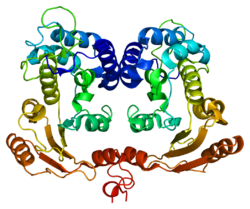Bst1 (Bone marrow stromal cell antigen 1, ADP-ribosyl cyclase 2, CD157) is an enzyme that in humans is encoded by the BST1 gene. [5] [6] [7] CD157 is a paralog of CD38, both of which are located on chromosome 4 (4p15) in humans. [8]
Contents
Bst1 is a stromal cell line-derived glycosylphosphatidylinositol-anchored molecule that facilitates pre-B-cell growth. The deduced amino acid sequence exhibits 33% similarity with CD38. BST1 expression is enhanced in bone marrow stromal cell lines derived from patients with rheumatoid arthritis. The polyclonal B-cell abnormalities in rheumatoid arthritis may be, at least in part, attributed to BST1 overexpression in the stromal cell population. [7]
CD157 and CD38 are both members of the ADP-ribosyl cyclase family of enzymes that catalyze the formation of nicotinamide and adenosine diphosphate ribose (ADPR) or cyclic ADP-ribose (cADPR) from NAD+, although CD157 is a much weaker catalyst than CD38. [9] [10] [11] cADPR is required for regulation of Ca2+ in cells. [10] Only CD38 hydrolyzed cADPR to ADPR. [11] CD38 is widely expressed in tissues, whereas CD157 is primarily found in gut and lymphoid tissue. [11]
CD157 has an important role in controlling the migration of leukocytes, the adhesion of leukocytes to blood vessel walls, and the passage of leukocytes through blood vessel walls. [8]
CD157 contributes to macrophage killing of the Mycobacterium tuberculosis bacteria responsible for tuberculosis. [12]
CD157 is highly expressed in acute myeloid leukemia, and is being evaluated as a diagnostic sign, as a treatment target, and as a means of monitoring treatment progress. [13]
BST1 and BST2 genes are unregulated by the Nicotinamide (NAM) metabolism pathway. [14]











